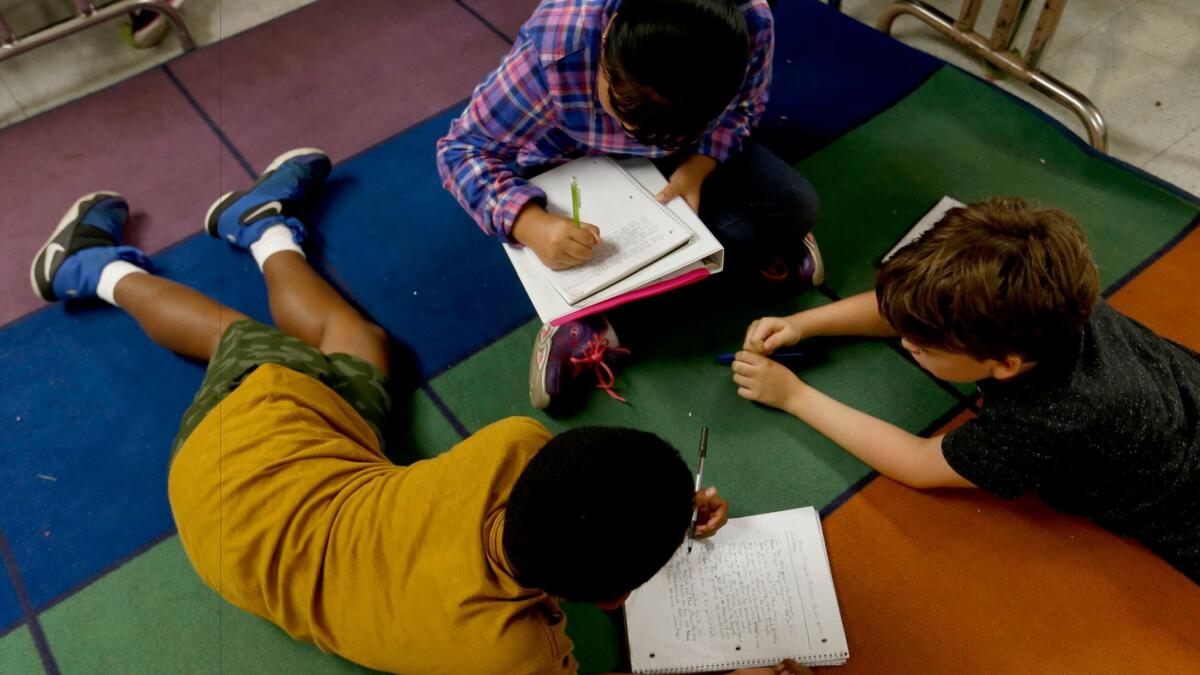What exactly is an ‘ineffective teacher?’ California’s definition doesn’t include measures of performance

Even after years of debate and litigation over teacher evaluations and tenure, California had no official definition of what constituted a bad educator — until now.
Under the federal Every Student Succeeds Act, states must report on whether disadvantaged students have a higher proportion of ineffective, out-of-field or inexperienced teachers than do their peers. But to supply that answer, California needed to define, concretely, what an ineffective teacher looks like.
On Wednesday, the Board of Education approved a profile that does not touch on teacher performance: An “ineffective” teacher is now officially one who is improperly assigned or does not have proper credentials.
In less than two months, the board must submit its plan for satisfying the federal law — which replaced the No Child Left Behind Act — to Education Secretary Betsy DeVos. Its members opted to address the requirement dealing with teachers Wednesday, but leave until later the completion of a formula for identifying low-performing schools, as the law also requires.
California's new education ratings tool paints a far rosier picture than in the past »
What, exactly, is an “ineffective teacher?”
The state’s new definition mirrors language in the Local Control Funding Formula law, as well as a proposal from the California Teachers Assn. union.
Tom Adams, deputy superintendent of public instruction, said California was using it “because that’s the system we have in place.”
But some education advocates were critical of the decision.
"It refuses to consider teacher effectiveness ... as something related to performance and impact on students,” the Education Trust — West, an Oakland-based nonprofit focused on closing the achievement gap, wrote in a letter.
Similarly, the Assn. of California School Administrators wrote that the definition misses "a teacher who is fully credentialed but ineffective in instructional practices."
Some, including Carrie Hahnel of EdTrust-West, have suggested considering teacher turnover and absentee rates to get at how well they are performing — without using the controversial, quantitative evaluation systems that rely on students’ standardized test scores.
Board President Mike Kirst said that he was interested in some of those ideas, but that there wasn’t enough data to justify their use. One board member said the conversation gave her “heartburn.”
How does California identify underperforming schools?
Where No Child Left Behind used a stringent system to reward and punish schools for their standardized test performance, Every Student gives states much more leeway.
At the bare minimum, the federal law requires that states identify the lowest-performing 5% of their high-poverty schools, as well as high schools with persistently low graduation rates, and help them improve.
The state recently created the California School Dashboard, a website that uses a variety of metrics to analyze schools and displays the results in a color-coded scheme: red is the worst, blue is the best. A Times analysis found that it was possible to have more than half of students underperforming on standardized tests and still be classified as "good" under this system.
California plans to use the dashboard color ratings to identify its lowest-performing schools: Those deemed red across all measures, or all red with one orange category, will be flagged. But by using that method, experts said, the state will be able to identify only one-third of the number of schools it would need to reach the full 5%.
So the board Wednesday also voted on a motion that said it needed one more year of testing and dashboard data to figure that out, thus missing the federal deadline. After a January meeting, they plan to flesh out their strategy and send it to the government as an addendum.
Board member Feliza Ortiz-Licon voted no, saying she wasn’t convinced that the plan showed precisely how the state would close achievement gaps. And Children Now, an education advocacy group, said using the dashboard model was a bad idea because it collapsed nuanced information into blunt categories.
The whole ineffective teacher definition gives me heartburn.
— California State Board of Education member Ting Sun
What will California do to help low-performing schools improve?
The state has proposed letting county education officials take the lead on holding districts accountable.
The Equity Coalition, an umbrella group representing more than 20 California education advocacy organizations, wrote in a long critique that the state’s education plan “offers far too few details regarding how school improvement will happen.”
Kirst said the lack of detail was deliberate, and part of a long-running effort to not let the federal government direct California’s schools. “The state plan is essentially a contract with the federal government,” he said. “The more details we include, the less flexibility that we have to adjust.”
Times staff writer Howard Blume contributed reporting.
Start your day right
Sign up for Essential California for news, features and recommendations from the L.A. Times and beyond in your inbox six days a week.
You may occasionally receive promotional content from the Los Angeles Times.




